Nothing gets on my nerves more than someone labelling any and all prehistoric reptiles (and sometimes amphibians and even fish) as dinosaurs. There is a certain geological and map shop (or was - it's now closed down) that I pass quite regularly, that for a long time had a sign in the window that read: "For Sale: Dinosaur Teeth (Mosasaur) 100 Million Years Old". Now, average Joe Bloggs reading this is probably thinking: "What's so wrong with that?". The problem is, mosasaurs were NOT dinosaurs. And this blog post is going to attempt to show that by demonstrating what is a dinosaur and why.
Before I get to the crux of this discussion, I feel obliged to give you a crash-course in cladistics. Cladistics is the science of classification that groups organisms together based on the degree of "relatedness" (this is slightly different to taxonomy - more on that some other time). Anyway, there are three ways to define a clade (group). Node-based, stem-based and apomorphy-based.

Node-based definitions are along the lines of : A + B, their most recent common ancestor and all of its descendants. For example Dinosauria can be defined as "Passer (sparrow) + Triceratops, their most recent common ancestor and all of its descendants". So basically, a dinosaur is any organism that branched off the line leading to Triceratops after the branch that ultimately leads to Passer. Naturally, node-based definitions are less reliable because it relies on being quite confident about which groups are the most "primitive" and which are the most "advanced".
Stem-based definitions are similar, but more easy to understand. They are in the form of: Everything closer to A + B than to Z, to use these diagrams. So, for instance, a stem-based definition of Dinosaur would be: all Dinosauriformes (the next rank up from dinosaur) closer to Tyrannosaurus and Triceratops than to Lagerpeton (a potential dinosaur ancestor, however, this definition dates from 2004 and since then other, more dinosaur-like animals have been discovered like Silesaurus - add this to the long list of topics to cover in the future).
Finally, apomorphy-based definitions are the ones that are most easily understood by the layperson, but don't always reflect true, natural groups. Apomorphies are characteristics that are unique to a particular group (or rather a unique combination of features). It is this definition that I wish to further explore here.
OK, now that that's out of the way we can get to the fun stuff! First of all, there is no simple way of identifying a dinosaur. However, a few generalisations can be made. Firstly, they could not fly (sort of - the origin of flight in the whole dinosaur-into-bird thing hasn't been pinned down yet, but it seems likely that true flight evolved with the birds). This means that the pterosaurs (not pterodactlys - more on that some other time) are not dinosaurs. And yes, technically speaking, birds are dinosaurs, but just for the sake of convenience, I'm only going to be discussing traditional, non-avian dinosaurs. Secondly, dinosaurs were not fully aquatic (some evidence suggests that duck-billed dinosaurs were partly aquatic and it is presumed dinosaurs could swim). Therefore, plesiosaurs and ichthyosaurs were not dinosaurs either (and the next time I hear someone call the Loch Ness monster a dinosaur I will scream).
According to Michael J. Benton (2004), the unique characteristics of Dinosauria are:
- Loss of the prefrontal
- An elongate deltopectoral crest on the humerus
- A brevis shelf on the ventral surface of the postacetabular part of the ilium
- An extensively perforated acetabulum
- A tibia with a transversely expanded subrectangular distal end, as well as as caudolateral flange, a depression for the astragalus, and an ascending astragalar process on the cranial face
"What the Jiminy Cricket does that mean?!?!" I hear you cry. Well, I'm glad you asked Sunny Jim, because I'm going to explain all.
1. Loss of the prefrontal
The prefrontal is a bone in the skull just in front of the frontal (hence the name). Most dinosaurs, technically, did have a prefrontal, however, it was mostly fused to another bone, the lacrimal. Their descendants, the birds, have lost this bone completely. In the picture below, of Dromaeosaurus, the prefrontal is the lime green bone just in front of the eye, above the lacrimal. Notice how small it is.
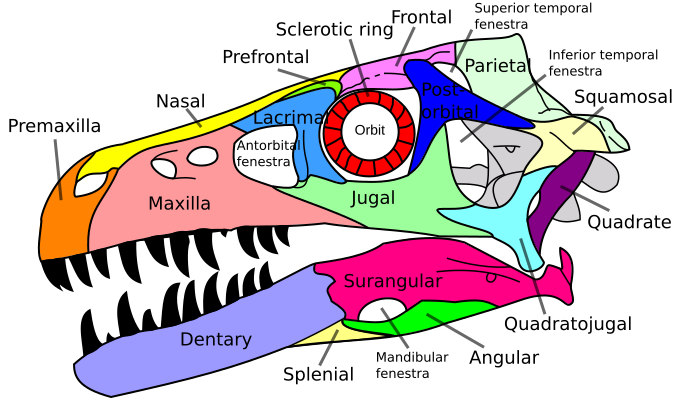
In this picture of a python, however, the Prefrontal is labelled as C. It is a much larger bone in other reptiles.

2. An elongate deltopectoral crest on the humerus
All this means is that dinosaurs have a long crest or ridge running along the top bit of the thigh.
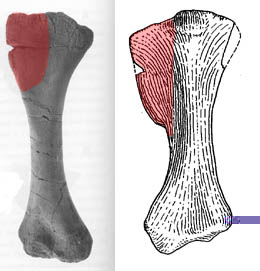
Compared to other reptiles, in this case Drepanosaurus (a prehistoric tree-climbing reptile that has defied every attempt to classify it), you can see the humerus marked Hu and in light green. (Sorry about the quality, it was the only picture of a non-dinosaurian reptile humerus I could find).
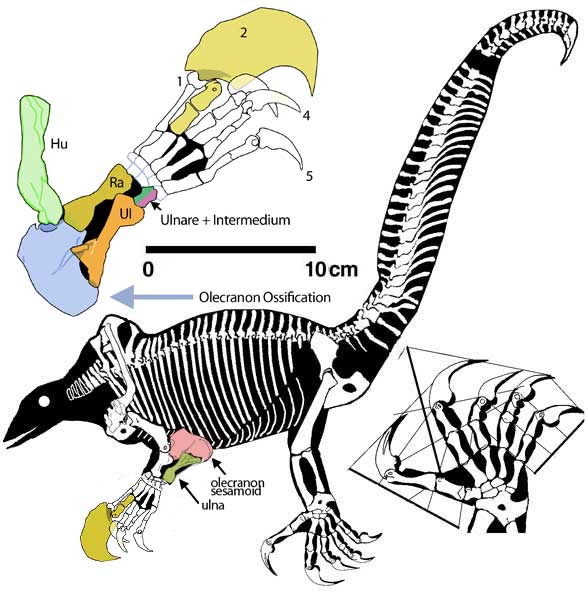
3. A brevis shelf on the ventral surface of postacetabular part of the ilium

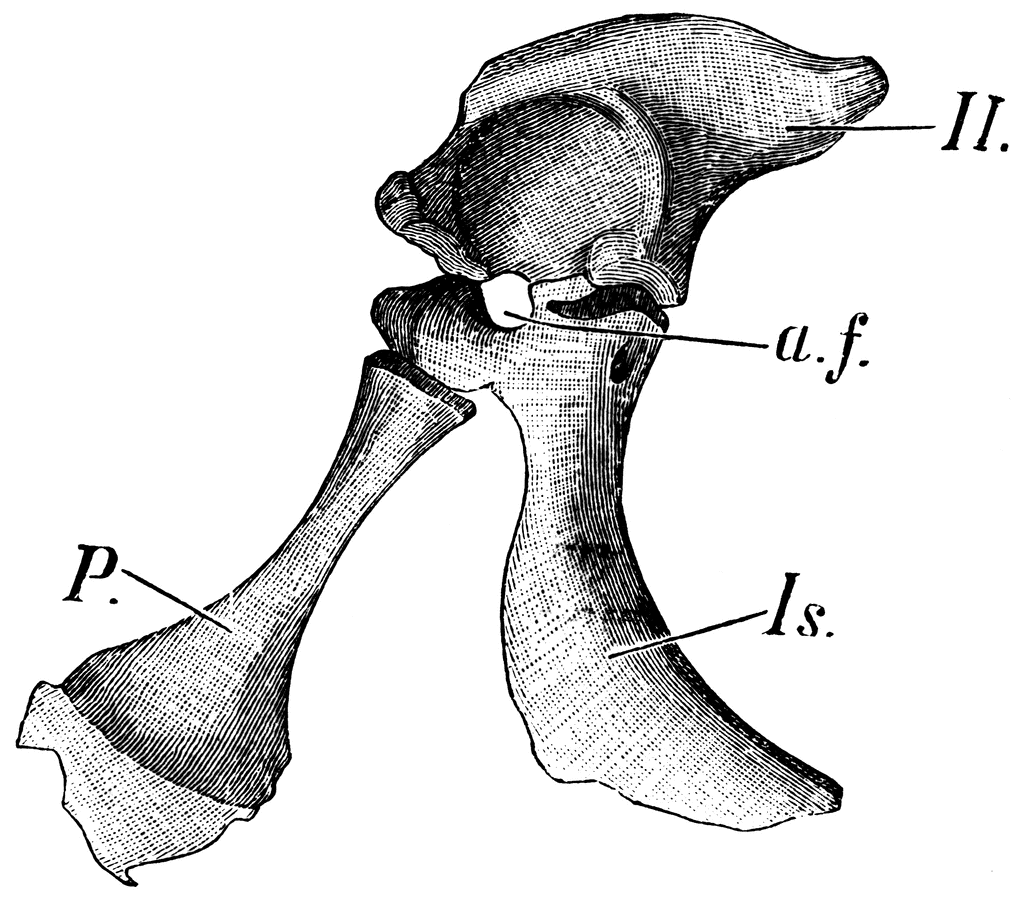
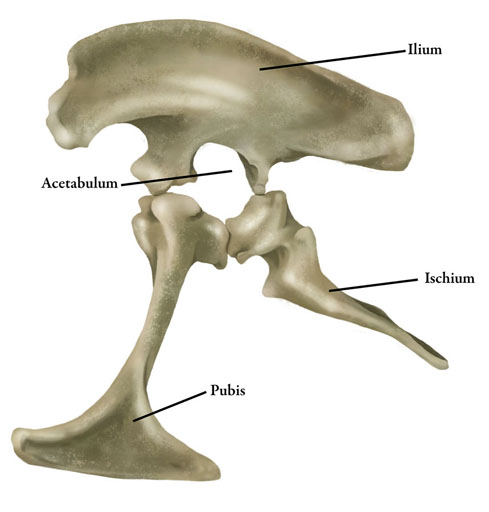 If you look at the crocodile hip image above, you'll notice that while there is a hole (the acetabular foramen) there is still a large furrow or socket where the femur connects to the hip.
If you look at the crocodile hip image above, you'll notice that while there is a hole (the acetabular foramen) there is still a large furrow or socket where the femur connects to the hip.
 It has a transversely expanded subrectangular distal end (which means the bottom part is stretched and is vaguely rectangle shaped), it has a caudolateral flange (which is a small ridge running along the bottom - not easy to see in this picture), a depression for the astragalus (which means it has a furrow at the bottom allowing the bone below (the astragalus) to connect to) and an ascending astragalar process on the cranial face which can be seen better in the image below - it's the part that looks like a triangle)
It has a transversely expanded subrectangular distal end (which means the bottom part is stretched and is vaguely rectangle shaped), it has a caudolateral flange (which is a small ridge running along the bottom - not easy to see in this picture), a depression for the astragalus (which means it has a furrow at the bottom allowing the bone below (the astragalus) to connect to) and an ascending astragalar process on the cranial face which can be seen better in the image below - it's the part that looks like a triangle)
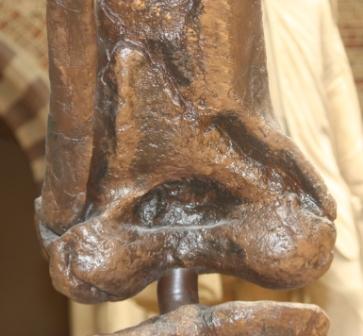
This means that, like the humerus, dinosaurs have a ridge on the bottom of the ilium (one of the hip bones), behind the acetabulum (the hip socket). On this diagram, the brevis shelf is marked bs.

Compared to this drawing of a crocodile's pelvis, the ilium (marked Il.) is much smoother and curved.

4. An extensively perforated acetabulum
What this means, simply, is that dinosaurs' hip sockets are actually holes rather than sockets.
 If you look at the crocodile hip image above, you'll notice that while there is a hole (the acetabular foramen) there is still a large furrow or socket where the femur connects to the hip.
If you look at the crocodile hip image above, you'll notice that while there is a hole (the acetabular foramen) there is still a large furrow or socket where the femur connects to the hip.
5. A tibia with a transversely expanded subrectangular distal end, as well as as caudolateral flange, a depression for the astragalus, and an ascending astragalar process on the cranial face
Let's have a look at a dinosaur's tibia, shall we?
 It has a transversely expanded subrectangular distal end (which means the bottom part is stretched and is vaguely rectangle shaped), it has a caudolateral flange (which is a small ridge running along the bottom - not easy to see in this picture), a depression for the astragalus (which means it has a furrow at the bottom allowing the bone below (the astragalus) to connect to) and an ascending astragalar process on the cranial face which can be seen better in the image below - it's the part that looks like a triangle)
It has a transversely expanded subrectangular distal end (which means the bottom part is stretched and is vaguely rectangle shaped), it has a caudolateral flange (which is a small ridge running along the bottom - not easy to see in this picture), a depression for the astragalus (which means it has a furrow at the bottom allowing the bone below (the astragalus) to connect to) and an ascending astragalar process on the cranial face which can be seen better in the image below - it's the part that looks like a triangle)
So that's that. If the fossil you are looking at exhibits all of these features then it is a dinosaur. For now. It hasn't always been like this. About 15-20 years ago, there were a lot of features in the ankle that were considered to be important. But now that we've found more crocodile ancestors, it seems that dinosaur ankles weren't that unique. Maybe in 10 years time, the definition will have changed but this will suffice for now.
I hope this has explained what a dinosaur is. In future, I hope to expand upon this, with more anatomy and with other groups. What's next? An article on my favourite dinosaur: Tyrannosaurus rex!
See also:
Other dinosaur posts
More dinosaur anatomy
More on dinosaur skulls
See also:
Other dinosaur posts
More dinosaur anatomy
More on dinosaur skulls
References
Benton, M. J. (2004) 'Origin and Relationships of Dinosauria', in, Weishampel, D. B., Dodson, P. and Osmólska, H. (eds) The Dinosauria (2nd Edition), London: University of California Press
No comments:
Post a Comment